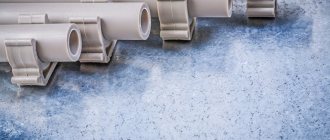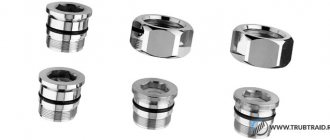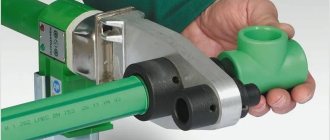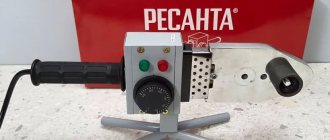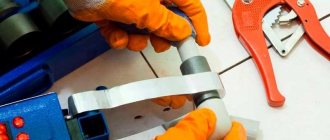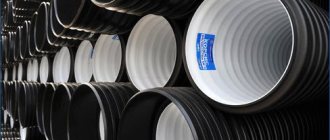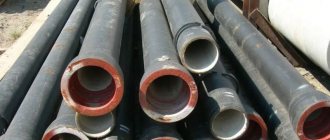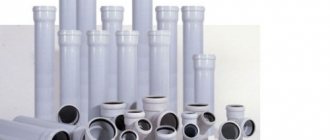Pipelines made of polypropylene, if assembled with high quality, can last up to half a century without repair. The popularity of plastic communications in the construction of individual houses is explained, among other things, by the fact that the installation of polypropylene pipelines can be done independently.
The choice of method for connecting plastic pipes depends on the availability of special tools, the nature of the materials being connected, and the purpose of the communications.
Polypropylene pipes: connection methods
The choice of technology for assembling a plastic pipeline depends on the type of products and their properties. The methods used for joining sections are divided into two large groups:
- The first one is “hot”.
This involves welding or soldering, that is, heating the material to change its state of aggregation. This method is used to form a deposit at the joint, and ensures the absence of leaks and uniform distribution of mechanical loads.
A welded joint is, first of all, a one-piece type of installation. This type of pipe connection is permanent and is used until the expiration date of the products. This method is more often used to achieve high pipeline strength. Soldering is done using special equipment or improvised tools.
Method of connecting polypropylene pipes by soldering Source vodatyt.ru
- The second is “cold”.
Involves connecting polypropylene pipes without soldering. This method is used when quick joining is necessary, in the absence of welding skills.
The installation method in this option is detachable or threaded. It can be used when connecting thin pipes, polypropylene and metal. When using this “cold” method, connecting elements are used - polypropylene fittings, the sizes and dimensions of which are selected to match the main product - pipes.
Knowing how to connect polypropylene pipes without soldering, you can pre-select elements suitable for operating conditions and ensure quick assembly.
Installation of polypropylene pipes using improvised means Source moikolodets.ru
Advantages of polypropylene
When creating a new water supply system in an apartment, many people choose polypropylene pipe products. This material, made of plastic, can be easily soldered by welding, and has a lot of other positive qualities:
- Long service life of more than 10 years. During the entire period of operation, these products are not subject to rotting and corrosion processes; plaque forms on the walls of these pipes. Provided high-quality soldering of such pipe products is performed, ideal seams and high tightness are ensured for decades.
- Water supply systems made from polypropylene pipes are easy to install. Their assembly resembles a regular construction set. During work, a minimum number of tools are used. A beginner can master soldering polypropylene pipes in one day.
- The versatility of the material. This quality of polypropylene is expressed in its wide application. It can be used to create cold and hot water supply systems. It is also often used to install heating in a home. Pipes made from this material are offered in stores in a wide range. They differ not only in their size, but also in the level of pressure that the pipe is able to withstand. The weight of polypropylene pipes is insignificant, which facilitates the process of installation work. It should also be noted that such pipes can be joined to any ends, which is how they differ from products made from other materials.
- Low price. If, when creating a water supply system, the owner’s main goal is to install a water supply system with minimal monetary costs, then polypropylene pipes are the best option.
- Convenient and affordable equipment. When creating a water supply system using polypropylene pipes, you cannot do without the use of spare parts and various accessories. There are no problems with purchasing, since they are presented in a wide range in most hardware stores. Depending on his financial capabilities, the home owner can choose affordable domestic or more expensive imported components.
“Hot” joining method: welding options
When using this method, 2 welding options are used:
- Soldering pipe to pipe is the most popular method.
- Fusion welding of couplings (adapters).
The first method is used when welding pipes with a diameter of more than 40 mm. The second is on pipes with a diameter from 16 to 40 mm. In this case, the fitting is needed not only to adjust the direction of pipe laying, but also as a supply of material for melting.
Various configurations of couplings (adapters) Source education-web.ru
Coupling configurations are selected based on the characteristics of the pipeline. The following types of adapters are available:
- Corners . Change of direction in any direction.
- Tees . Distribution of water supply and change of direction.
- Couplings . Docking without changing direction.
The following elements also apply:
- Bypass fittings.
- Ball valves.
- Combined products including metal-plastic.
- Threaded inside or outside pipes.
How to choose
When choosing fittings, several factors should be taken into account. If after installation it is located in concrete, then stray currents will cause the destruction of the metal connection in about 18-20 years. It is for this reason that it is better to choose solder fittings for connections that will have contact with concrete. If you decide to install the water supply yourself, then it would also be an excellent solution to use such fittings. The soldering iron and fittings are inexpensive, so it doesn’t hurt to buy a few more items than you need just to practice welding them first.
If you are looking for fittings of various categories - for example, compression and crimp, then you should pay close attention to the dimensions of the walls and their thickness. In some models, the abbreviation SDR is written, which means the ratio of wall thickness and tube diameter
If this indicator differs for the specified elements, then you will not be able to do something. Either the fitting tube will be larger than the diameter of the pipe from the inside, and it will simply not be possible to install it without damaging the rubber seals, or it will simply not be possible to ensure that it is pressed tightly against the pipe and various seals.
Before choosing different models, you should ask the point of sale for a document of conformity. Everything that is produced or legally supplied to Russia must have documentation and fully comply with GOST. In addition, this will be a sign that this is not a fake. But materials that do not have documents are most likely imported illegally or created illegally, which means it is not possible to check their characteristics.
Mechanical joining method without soldering: connection options
Soldering as a method of joining pipeline sections is more often used during installation supervision in production. In everyday life, the most popular technologies are express installation without welding.
The time-tested practice of joining without the use of special tools ensures high quality joints of plastic pipes without soldering using couplings.
The widely known method is based on the use of shaped parts. With their help, you can not only ensure the continuation of the water supply circuit, but also change its direction, distribute the working medium or block the flow.
Advantages of installation technology without heating:
- Finished polypropylene products are cheaper to connect using this method than metal ones due to the low cost of fittings.
Connections of plastic pipes without soldering using couplings Source stroy-podskazka.ru
- The design of the fittings makes it possible to manually assemble a complete engineering system of drainage, water supply, and sewerage.
The size and technical capabilities of parts are determined by their configuration (shape, wall thickness, combination).
Connection using compression fittings
When choosing how to connect plastic pipes for water supply without soldering, many people often use the compression fitting method. With this connection method, the process of heating adjacent parts is eliminated. A special coupling, under mechanical action (crimping), reliably fixes the two ends of the tubes equipped with o-rings inside. After installing the adapter, the joints are lubricated with silicone sealant.
Switching from metal-plastic to polypropylene using fittings is an indispensable way to join pipes made of different materials.
The advantages of this method:
- a minimum set of tools is used for installation;
- Even a beginner can trust the pipeline connection;
An example of lubricant used when installing polypropylene pipes Source construct.smazka.ru
- a reliable connection is created at the installation site of the compression fitting;
This method, first of all, is good because it can be used when updating cast-iron water pipes with polypropylene analogues. This method is also in demand when assembling heating systems, including the installation of radiators.
Connection using adhesives
Among the docking options that make it possible to do without special equipment is the use of assembly adhesives.
The base composition of the adhesive is polyvinyl chloride mixed with a solvent. Manufacturers also add various additives and plasticizers to it to improve adhesion at joints.
Advantages of the method:
- joining products using an adhesive provides the assembled structure with the necessary characteristics of strength and tightness;
- upon completion of work, a reliable connection is formed at the installation site, invisible during visual inspection;
- No special skills are required for docking.
Important ! During work, safety precautions should be observed, do not work near open sources of fire and avoid contact of the composition with the skin.
Fitting polypropylene pipes before gluing Source www.asvshop.com
See also: Catalog of companies that specialize in engineering communications.
How to install with glue
Before connecting polypropylene pipes, you need to prepare the necessary parts, tools and provide conditions for installation work.
The surfaces on which the adhesive composition will be applied should be treated with a degreaser. To apply the composition, a brush with bristles made from natural materials is suitable. It is also recommended to ensure the room temperature ranges from 5 to 35 degrees.
Considering that the pipeline parts will be joined with a minimum gap, a thin layer of glue will be sufficient. Holding the pipes until they set usually does not exceed 20-30 seconds. Upon completion of work, it is recommended to ventilate the room well, while drafts should be avoided.
Types of connections without welding
Methods for joining polymer pipelines can be classified as:
- crimping;
- detachable;
- threaded
Soldering pipes without a soldering iron. How to weld polypropylene without a soldering iron
Crimping
This is the name for units using special collet fittings. Their installation is carried out with special keys. The purpose of the crimping device is to ensure a tight, hermetically sealed connection between a metal water pipe and a propylene pipe.
The advantages include speed of installation and high tightness of connecting nodes. The downside is the complexity and high cost of collet devices.
Detachable
In cases where the pipeline system requires periodic disassembly of units, the joints are made detachable. For this purpose, special combined fittings are used. Threaded metal inserts are inserted into the plastic at one end, and a landing cone with a union nut is inserted into the other pipe. The nut is screwed onto the counter thread, the cone fits tightly into the seat, forming a strong, tight connection. To disassemble, just unscrew the nut and move the ends apart.
The advantage of this method is that in case of an emergency or during repair work, you can quickly isolate the desired section of the water supply system by disassembling detachable connections and installing plugs.
The disadvantage of this connection method is that it is difficult to install.
Threaded
Threaded connections are another way to connect plastic pipes without a soldering iron. The elements of polymer water pipelines are joined using polypropylene, combined or metal fittings of various designs and sizes.
The tightness of the connecting points is achieved by installing sealing gaskets or tying the contact surfaces with FUM polymer tape or tow. The strength and reliability of the fastenings is ensured by bolt ties.
The advantage of this method of joining polymer water pipes is undoubtedly the speed and ease of installation of connecting units. A negative point is the presence of places in the connecting nodes with a high risk of leaks.
How metal-plastic and polypropylene pipes are joined
There is only one way to install pipes made of different materials. This is a threaded installation, since soldering and gluing products cannot be used here.
This is explained by the fact that the joint must not only be hermetically sealed, but also be able to experience high dynamic loads (maximum pressure difference).
Quick installation of pipes from various materials Source glawtruba.ru
Before connecting a metal-plastic pipe with a polypropylene pipe, you need to select the necessary parts:
- Metal-plastic products are equipped with special tips.
- Polypropylene sections, in turn, are equipped with a coupling on which a thread is applied.
Joining of polypropylene and polyethylene materials
The connection of polyethylene and polypropylene parts of the pipeline may be required when installing cold water supply. They also use specially made fittings for threaded and flanged connections and soldering.
- The first connection method, when the fitting involves welding with a polypropylene part and a crimp connection with a polyethylene pipe.
- The second method is a flange connection. The flange joint is sealed by installing a rubber gasket.
The need for such a combination arises if the supply to the house is made of polyethylene materials, and the internal wiring is made of polypropylene.
Bell-shaped technology for assembling plastic pipelines
Fixation using this method is justified only when operating in low pressure systems. The insert into the socket ensures quick and easy installation, suitable for sewer and drainage engineering systems.
The ends of the pipes at the installation site must have a precisely adjusted diameter.
The section with the socket is, accordingly, inserted into the end of the pipe with a seal. The work will not require special knowledge or the purchase of special fittings.
The procedure for assembling pipelines by driving them into a socket
To eliminate possible diametrical errors in the joined sections, there is a rubber ring in the socket tip. The task of this element is to ensure tightness under mechanical stress on the pipeline.
Assembly of various polypropylene pipes Source www.uponor-usa.com
To facilitate the driving process itself, lubricant is used. The composition is applied to the smooth part of the end cut. The docking process is controlled using markings. This will prevent the user from driving the pipe too deep and damaging the section.
Normalized immersion of the bell allows not only to ensure material savings, but also to maintain a standard gap, which is necessary to compensate for loads during linear expansion - phenomena that occur with temperature differences.
Welding and installation of a separate part of the pipeline system
When soldering a polypropylene water main, they always try to install individual sections of the water supply in a place with large free space and at a convenient height. To do this, you will need basic tools, a drawing of the highway and the correct procedure for carrying out the work.
Typically the hardest side to weld is on the wall with the two corner fittings, so it is welded first and secured with clips or dowel sleeves. Afterwards, from the corner fittings, further installation of sections of the line is carried out, moving on to soldering work directly near the walls. For ease of installation, it is necessary to provide in advance a place to install the soldering iron on a stand or organize its hanging.
Classification of fittings and adapters
Assembling pipelines using special nozzles is the most popular method of wiring engineering systems. In order to select the necessary types of fittings for polypropylene pipes, you should familiarize yourself with their detailed classification.
For the manufacture, release and supply of technical polypropylene products, the provisions of state standard No. 52134 of 2003 are used.
Types of fittings for polypropylene pipes Source ecomont.ru
Transitional coupling for reliable connection
The polypropylene transition coupling, as well as the split polypropylene coupling, are used for the installation of pipelines. It is lightweight, minimizes labor and time costs for pipeline installation, and is characterized by a long service life, practicality, durability and reliability due to the quality of workmanship and the material endowed with special properties.
The polypropylene transition coupling differs in type and diameter; it is selected based on the type and diameter of polypropylene pipes. Its feature is to ensure high connection reliability. Even after a long service life, it will not lose its properties and will clearly perform ozone functions.
Installation parameters of pipes and fittings
In the selection of polypropylene pipes and adapters to match the technical design of the building, simple physical principles are used.
The dimensions of fittings for polypropylene pipes in mm can be selected depending on the diameter of the polypropylene pipes, their thickness, and resistance to temperature influences.
For a home where there is free space and the mechanical strength of pipelines is important, elements with a thickness of 16 mm or more are laid. This takes into account the difference between the internal and external diameters of the products. The thickness of the pipes and fittings will compensate for the missing characteristics.
The first among the installation parameters is the operating pressure, indicated by the PN marking.
| PN10 or 10 bar | PN16 or 15 bar | PN20 or 20 bar | PN25 or 25 bar | |
| Pipe outer diameter | 16-110 mm | |||
| Wall thickness | From 1.9 to 10 mm | From 2.7 to 18.4 mm | From 3.4 to 6.9 mm | |
| Maximum temperature | 45°C | 60°C | 75°C | 95°C |
| Scope of application | Cold water supply, low pressure pipelines | |||
| Reinforcement | No | No | Eat | Eat |
In this case, you should not focus only on the wall thickness parameters. If there is reinforcement (fiberglass), the outer diameter of the pipes increases.
Selecting fittings for polypropylene pipes by size is not so difficult, you just need to find tables of recommended adapters and their diameters.
Before installing pipes at home without a soldering iron, you need to select the sizes of fittings and couplings in mm or inches Source image.isu.pub
Using flanges
This connection is made using adapter bushings welded to the ends, or slip-on steel flanges (profiled and smooth) with threads on one side. They are installed without welding. Among the advantages, the high reliability of the joints is noted, withstanding high temperatures and pressures of up to 16 atm. The connection can be made on pipelines of different diameters from 2 to 120 cm.
Docking begins by pulling the flange onto the pipe and putting on the rubber gasket. It is installed at a distance of no more than 10 mm from the end. The flange is moved towards the gasket, and another pipe is prepared in the same way.
The bolts are tightened carefully so as not to crack the plastic.
Flange connection of plastic pipes
Fastening methods used in everyday life
Each apartment owner independently determines the level of installation quality he requires. Some people use soldering, while others use adapters or other alternatives.
"Hot" soldering of pipes
Considering soldering as the most reliable and durable method of fastening, some private property owners use this method of pipeline installation. In the absence of special equipment, they use a gas burner. In this case, you can save on purchasing a soldering iron and work with pipes of any diameter.
Workflow Features:
- The gas burner must be selected according to the type of fuel used. The gas with the highest combustion temperature is suitable for thicker pipes.
- It is best to select pipe sections of the same diameter. This will ensure an aesthetic appearance of the engineering system, preservation of operating parameters in all sections of the pipeline and the absence of difficulties during soldering.
- Before starting installation, it is recommended to mark (cut) the entire contour, clean the ends of the joints, and degrease them with a special compound.
Installation of polypropylene pipes using a gas burner Source ytimg.com
System planning
Due to the fact that PPR pipes do not bend, when developing a wiring diagram it is necessary to create as few detours and turns as possible. After all, they are all made using fittings, and they have a significant cost (compared to a pipe). Therefore, we try to optimize the wiring - make as few turns, detours and bends as possible.
Serial (Tee) connection
Installation of water supply from polypropylene pipes with serial connection of consumers (plumbing and household appliances) is used in small systems. Usually they have 5-6 connection points. With this arrangement of the water supply system, one pipe leaves the riser and it sequentially bypasses all connection points. In the case of PPR plumbing, all branches are made using tees, which is why this type is also called tee.
Installation of water supply from polypropylene pipes with serial connection of consumers
The advantage of this system is that a small number of pipes are needed, and the disadvantage is that the pressure on each branch drops. As a result, with one or two working disassembly points, the third, located further from the riser, may simply not have enough pressure.
Parallel (collector) wiring
A parallel connection circuit is also called a collector circuit. This is because after the outlet from the riser, a special device is installed - a collector. This is an element with one input and a number of outputs. Available in polypropylene and metal. For water supply, polypropylene manifolds are more suitable (and cheaper).
The connection diagram is such that a separate pipe runs from each branch to each consumer (sometimes to a small group of consumers).
Parallel scheme for installing a water supply system from PPR pipes
The advantage of such a system is that the pressure at all water points is the same, the disadvantage is that a lot of pipes are required. Another plus is that if any branch fails, only one consumer does not work. The rest of the system is functioning normally. By the way, in order to be able to turn off individual devices, valves are installed at the outlet of the collector (usually ball valves, but if you need the ability to adjust the pressure, you can install a valve).
Plumbing and household appliances
In each method of installing a water supply system made of polypropylene pipes, a pipe is suitable for a specific consumer. There are two ways to connect to the system: flexible and rigid connection.
Rigid liner is more reliable: PPR pipes and fittings have high strength. Moreover, in this case there is only one thread - at the consumer connection point. But this type of eyeliner requires high precision: the error can be only a few millimeters. This is difficult to achieve when installing a polypropylene water supply with your own hands, so flexible hoses are often used. Just be careful, in some cases it is impossible to use it: connecting gas boilers or gas water heaters, supplying water to storage water heaters, water heated towel rails is recommended only using a rigid connection.
Rigid liner options
Soft eyeliner, on the contrary, does not require high precision - errors are leveled out by a flexible stainless steel braided hose or a hose that is used to connect a washing machine or dishwasher. The tubes are removed approximately in the area where the equipment is installed or the plumbing is connected. It ends with an adapter for metal, to which a flexible hose is connected (its other end is connected to the device).
Flexible hoses are connected to the adapters
This option is less reliable, since much depends on the quality of the flexible liner. Also not the most pleasant moment is the presence of two threaded connections, and this is a potential place for a leak to appear.
Briefly about the main thing
Lightweight, durable plastic pipes are easily connected to any materials in a variety of ways. There are detachable and non-detachable installation methods:
- The first option includes the use of compression fittings, threaded elements, and couplings.
- The second option uses “cold” and “hot” welding and gluing. The connection occurs using special compounds, for example, solder tapes and pastes, glue, epoxy resin, or simply by heating the plastic to the melting point.
When choosing how to connect metal-plastic with polypropylene at home, pay attention to the technology of compression fittings or threads with plastic elements.
Today, this is the only way to connect dissimilar sections, for example, cast iron and plastic. With compression fittings, the pipe connection can be quickly updated if necessary by replacing parts. The same cannot be said about the soldering method.
When there is no special tool at hand, electrical fittings can be used. Once connected, these elements quickly solder individual sections of the pipeline.
Before installation using the detachable method, you need to select fittings for the pipeline based on operational characteristics (temperature, pressure, dimensions). Fittings marked PPG are suitable for heating systems.
Ratings 0
Ways to join metal-plastic pipes and PEX pipes
Metal-plastic elements and PEX pipes are often joined using the same method. Here we will describe in detail the technology for installing heat pipes from the above materials.
The connection of metal-plastic pipes is carried out in two ways:
- using compression fittings;
- using press fittings (pressure testing of heating pipes).
Joining pipes with compression fittings
This type of fitting is more convenient to use. Compression fittings can also be used to assemble cold water supply systems. Installation of a pipeline carrying hot water is also carried out by builders using the mentioned fittings.
When assembling the above-mentioned pipelines, there is no need for special equipment for stitching metal-plastic and polypropylene. In order to connect the pipe parts together, you only need a pair of wrenches and pruning shears.
The heating elements are connected according to the following algorithm:
- Initially, a crimp nut is placed on the end of the pipe on the joining side.
- Next, a split-type ring should be put on behind the nut, and the edge of the ring should be placed at a distance of 1 mm relative to the pipe cut.
- Then the pipe is pushed all the way and secured to the fitting fitting. In this case, chamfering the pipe is not required.
- The crimp nut is installed using wrenches.
Compression Fitting Parts and Assembly Procedure
When tightening the nut, it is not recommended to use excessive force, as there is a high probability of cutting through the pipe.
Joining pipes using press fittings
Press-type fittings for metal-plastic pipes, as well as cross-linked polypropylene, make it possible to reliably connect parts of the heating system. Unfortunately, this design cannot be separated in the future. To perform installation in this way, you will need to use a special press tool.
In order to connect the previously mentioned heating elements using fittings, you should follow the following instructions:
- A clamping threaded sleeve must be placed on the end of the pipe.
- Then an expander with the required cross-section is placed into the pipe until it stops.
- The expander handles are slowly connected to each other and fixed in this position for a short time.
- The fitting is inserted into the pipe. Due to its unique molecular composition, the pipes undergo shrinkage, which will help tightly fix the fitting to the pipe.
- The pipe is securely pressed onto the fitting using a manual or hydraulic press.
Crimping using a special tool
Installation work
When starting to work with polypropylene pipes, I first of all remembered their main qualities:
- The low price allowed me, without much outrage on the family budget, to purchase all the necessary plastic products, including connecting fittings, with some reserve . After all, even with the appropriate experience, no one is immune from making mistakes, and in case of an unsuccessful operation, it is better to have replacement parts on hand, rather than run to the store to get them, leaving behind an unfinished pipeline and an unwatched TV series;
Photos of polypropylene pipes and connecting fittings that may be useful to you during installation work
- Simple connection instructions including hot and cold methods. But simplicity does not exclude the need for a special tool for each option. Next, I will describe both in detail, since I used both soldering and crimp fittings in different areas. It’s better for you to make your choice in advance in order to ensure that you have the appropriate equipment. You can do this immediately after reading the article;
- No corrosion processes . The plastic surface is not subject to either internal corrosion, which can be caused by the transported liquid, or external corrosion, which usually appears after laying the pipeline in the ground. Thus, when laying an underground water supply system, I knew that it would last for decades, but only taking into account high-quality and absolutely tight connections.
If you plan to use polypropylene pipes for installing a heating system, then I recommend purchasing reinforced samples that can withstand high temperatures, which will eliminate the risk of an emergency.
Layers of reinforced pipe
Based on the above, I purchased a supply of materials, took out the necessary tools and prepared to make high-quality connections that could be left unattended for many years.
Hot method
Where I planned to lower the water supply line underground, I had no doubts about the choice of connection method: soldering only. The melting point of propylene is only 260 degrees Celsius , and after hardening, completely sealed seams . In addition, the process itself goes quite quickly. In this case, the impossibility of dismantling did not bother me at all.
When laying pipelines indoors, welding is also great. The only exceptions may be those areas where pipe disassembly is required, or a situation in which it is not at all possible to obtain a pipe soldering iron.
If you are planning a one-time installation, then it is not necessary to purchase an expensive welding machine for plastic pipes; it would be more rational to rent one.
Simple pipe soldering iron
Before connecting polypropylene pipes using the “hot” method, in addition to the “iron”, I also prepared the following tools:
| Name | Purpose |
| Tape measure and pencil | Applying all necessary markings |
| Soldering iron attachments | Melting pipes and couplings of different diameters |
| Shaver | Cleaning of reinforced products |
| Special scissors or hacksaw | Pipe cutting |
| Sharp knife | Edge correction |
Everything except the shaver, which is needed only when working with reinforced pipes, can usually be found complete with a pipe soldering iron
Now I will describe to you in detail how polypropylene pipes are connected, you will actually have time to install small sections while watching commercials on TV:
Diagram showing the stages of connecting polypropylene pipes
If this is your first time starting to solder plastic pipes, I recommend that you first practice on a couple of products that will not be part of the system being installed. This way you will get the hang of it and be able to avoid common mistakes when performing “finishing” work.
- Preparation:
- I took the soldering iron out of the suitcase in which it was located and placed it on a level and stable oak table . You can place the device on the floor or on the asphalt, the main thing is that it has a secure position, because you will have to deal with high temperatures;
A securely installed soldering iron is a guarantee of fire safety
- Then I inserted nozzles corresponding to the diameters of the elements to be soldered . In this case, a product is installed under the pipe in the form of a kind of “bowl”, which wraps around its edge from the outside, and under the coupling a pipe-shaped element that enters it and performs melting from the inside;
An example of two nozzles installed on opposite sides of the heating sheet of a soldering iron
- Turned on the device . If your device has a power regulator, then set it to 260-270 degrees Celsius. If this is not the case, then the unit will warm up to the specified temperature automatically;
Pipe Soldering Iron Regulator
- Marking. Here I have already moved on to working with the pipes themselves. Using a tape measure and a pencil, I marked out the required sections to form the pipeline . In addition, I measured the depth of the heating elements and, adding a couple of millimeters, applied it to the soldering areas. This can be done after cutting the products. This technique will help you control the immersion of the edge of the segment into the nozzle, since excessive melting can lead to the formation of a bulge in the seam, preventing the passage of liquid;
Drawing control lines
- Cutting. The main thing here is to maintain a right angle. Thanks to having some experience, I have no problems with this, that is, I brought the scissors evenly to the line and made a clear cut in one smooth, strong movement . Also try to cut without worry and with the necessary effort. Otherwise, if you make oblique cuts, you will have to straighten them with a hacksaw or knife. It is also worth noting that when using reinforced pipes, you must first remove the top layer of plastic and the foil laid underneath with a shaver;
Cutting a polypropylene pipe with scissors
- Heat. At this stage, I put the prepared coupling on the mandrel, and with some delay inserted the pipe section into the sleeve nozzle . Why late? Because the walls of the connecting element are thicker and, accordingly, they will take longer to melt, that is, a head start will not interfere with them. The products should be kept in this position, guided by the following table:
| Section, cm | Melting time, s |
| 2 | 6 |
| 2,5 | 7 |
| 3,2 | 8 |
| 4 | 12 |
| 5 | 18 |
| 6,3 | 24 |
| 7,5 | 30 |
| 9 | 40 |
| 11 | 50 |
The process of melting plastic pipeline fragments
- Docking. After the time indicated above had passed, I removed both fragments with molten edges from the welder and connected them , again, strictly at right angles, after which I kept the time indicated in the following table:
| Section, cm | Connection time, s | Cooling time, s |
| 2 | 4 | 2 |
| 2,5 | 4 | 2 |
| 3,2 | 6 | 4 |
| 4 | 6 | 4 |
| 5 | 6 | 4 |
| 6,3 | 8 | 6 |
| 7,5 | 10 | 8 |
| 9 | 11 | 8 |
| 11 | 12 | 8 |
This is how plastic fragments with melted edges are joined
Under no circumstances should you rotate the products being joined while they are solidifying, as this may cause the seal to break.
- Control. I ran water through the finished pipeline and checked all joints for leaks . If you suddenly find one in your place, then cut out the problem area and weld a new section in its place.
Cold method
Compression fittings allow you to connect polypropylene pipes without soldering. All you need besides the connecting elements themselves is a crimp wrench , which, as a rule, is sold with them.
Compression fitting structure
| Designation in the figure | Explanation |
| 1 | Union nut |
| 2 | Collet |
| 3 | Rubber sealing ring |
| 4 | Thrust sleeve |
| 5 | Frame |
I performed the process of connecting pipes using the “cold” method as follows, when I didn’t have an “iron” at hand, and it was necessary to urgently restore the damaged section of the water supply:
- Measured and cut the required piece of pipe;
Cutting plastic pipe
- I calibrated the hole . It is very important that its cross-section ideally matches the diameter of the fitting tail;
Calibration of the cut product
- a crimp coupling on the edge of the pipe ;
Crimp sleeve on prepared edge
- Then I inserted the fitting itself inside;
Installing a compression fitting
- I crimped the coupling with a special key, securely fixing it on the pipe;
Fixing the compression fitting with a crimp wrench
- I checked the coupling for the presence of characteristic grooves, indicating a high-quality connection.
Ready connection
The described method also well solves the problem of how to connect a metal pipe to a polypropylene pipe. To do this, simply select the appropriate compression fitting, one of the ends of which is equipped with a metal thread of the required pitch and diameter.
Example of a transition element for connecting to metal pipes
If you have a question: “How to connect a HDPE pipe to a polypropylene pipe?” Then again you can turn to compression fittings, since welding here most likely will not work due to the significant difference in the melting temperatures of these materials. At least I wouldn't risk it.
Before connecting polyethylene pipes using soldering, you need to acquire other more powerful equipment
And a little fly in the ointment: despite some universality of the “cold” connection method, it requires much more time to implement. So, if you have to install a long pipeline, then during the advertising on TV you may not have time to complete the task.
Recommendations
Try to solder less by weight
Without experience, in order to understand how to solder pipes correctly, you can make several training connections. It is convenient to work with short connections by placing the welding machine on the table; in this position, you can do all possible work, and joining a partially laid line is more difficult. The soldering iron nozzle is put on a fixed polypropylene pipe, and a tee is inserted into the second part, while the device is supported by weight. When making a highway, you need to monitor the order of the connections being made. Try to avoid joining in hard-to-reach places where it will be difficult to use a soldering iron.
It is important to keep the material clean and dry, because dirt and moisture reduce the quality of the pipe connection. Even a small amount of moisture deforms the material when heated. The chemical composition of pipes from different manufacturers may not be the same, this will lead to leaky joints. It is necessary to buy all the material - pipes and fittings - from one manufacturer.
The temperature in the room where polypropylene is installed should not fall below +5°C.
How to operate a welding machine
Welding polypropylene
The principle of connecting a pipeline is to heat the elements and quickly connect them. Household pipe welding machines have a power of up to 1 kW. It is enough to quickly and efficiently heat the material, but for industrial purposes more powerful and expensive devices are used. The soldering iron comes with attachments that correspond to the diameter of various pipes. The pipe is heated from the outside, and the fitting from the inside.
The operation of the soldering iron begins with connecting it to the network and setting the desired heating temperature, depending on the diameter of the plastic pipes being welded. The average value is 250–270°C. Such a high temperature requires caution; touching a hot part will cause a burn; for safety reasons, you should wear gloves.
How to properly secure a pipeline
Good heating or plumbing installation is not only about the quality of the connection, but also about the implementation of knowledge on how to install assembled polypropylene pipes.
Proper fastening of plastic wiring to the walls will prevent it from sagging and deformation when heated with hot water.
When making repairs, sometimes you have to forcefully pull the pipe out of the clips, so the dowels must firmly fix this small element against the wall
For fixing pipes, the following are used: clips (single, stacked, with a clamp) and clamps (on a hairpin, paired, wall).
New models are constantly appearing on the market, so it is better to select clamps and clips directly in the store. Clips basically ensure free movement of pipes along the axis, and clamps firmly fix them in one position.
A particularly dangerous consequence of improper installation is neglecting the thermal expansion of pipes.
The length of simple PP pipes can change by 10-15mm/1m when heated. When they are rigidly fixed, deformation occurs at the adhesions, which can lead to rupture of the connection. To relieve stress, the following types of compensators are used:
- Z-shaped;
- U-shaped;
- L-shaped
- ring.
Rules for working with a compensator:
After soldering the expansion joints and attaching the pipes to clamps and clips, you can begin testing the assembled system.
Specifics of working in conditions of negative temperatures
Carrying out installation work in low temperature conditions involves making changes to the key time periods of heating and fixing the workpieces. But the installation features are not limited to this. The effect of frost on the polymer is reflected in the hardness of the material - it becomes brittle, which complicates cutting and requires more attention during transportation.
The issue of fragility can only be resolved by careful work. It is better to cut in a heated room. The permissible temperature limits are in the range 0-+5℃. Lower rates lead to crystallization processes that do not bypass polymer materials. In such conditions, there is a high risk that the pipes will begin to crumble.
Cutting blanks in a heated room
Standards for thermal exposure are determined for room conditions. The lower the thermometer reading, the longer it takes to heat the polypropylene. Based on practice, experts recommend first bringing the material to +20℃, then using a standardized timer. At the same time, it is impossible to heat the device above +260℃, as this may negatively affect the quality of the pipes.
There is an opinion that all standards when working in cold weather should be increased to 50%. This absolutely does not apply to commit time. The connection of elements here must be carried out in an accelerated mode, so that with rapid cooling a full-fledged polymerization process is possible. Delay in this case will lead to the unit being of poor quality and not lasting long due to early depressurization.

